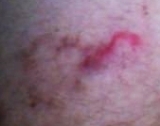
Cutaneous larva migrans
Encyclopedia
Cutaneous larva migrans is a skin disease in humans, caused by the larvae of various nematode parasites of the hookworm
family
(Ancylostomatidae
). The most common species
causing this disease in the Americas is Ancylostoma braziliense
.
Colloquially called creeping eruption due to the way it looks, the disease is also somewhat ambiguously known as "ground itch
" or (in some parts of the Southern USA) "sandworm
s", as the larvae like to live in sandy soil. Another vernacular name is plumber's itch. The medical term CLM literally means "wandering larvae in the skin".
and thus create the typical wormlike burrows visible underneath the skin. The parasites apparently lack the collagenase enzyme
s required to penetrate through the basement membrane
deeper into the skin.
Hookworm
The hookworm is a parasitic nematode that lives in the small intestine of its host, which may be a mammal such as a dog, cat, or human. Two species of hookworms commonly infect humans, Ancylostoma duodenale and Necator americanus. A. duodenale predominates in the Middle East, North Africa, India...
family
Family (biology)
In biological classification, family is* a taxonomic rank. Other well-known ranks are life, domain, kingdom, phylum, class, order, genus, and species, with family fitting between order and genus. As for the other well-known ranks, there is the option of an immediately lower rank, indicated by the...
(Ancylostomatidae
Ancylostomatidae
Ancylostomatidae is a family of worms that includes the hookworms.- Genera of Ancylostomatidae :* Agriostomum* Ancylostoma* Cyclodontostomum* Galonchus*Monodontus*Necator...
). The most common species
Species
In biology, a species is one of the basic units of biological classification and a taxonomic rank. A species is often defined as a group of organisms capable of interbreeding and producing fertile offspring. While in many cases this definition is adequate, more precise or differing measures are...
causing this disease in the Americas is Ancylostoma braziliense
Ancylostoma braziliense
Ancylostoma braziliense is a species of Ancylostoma.It can cause creeping eruption....
.
Colloquially called creeping eruption due to the way it looks, the disease is also somewhat ambiguously known as "ground itch
Ground itch
Ground itch refers to the inflammatory reaction resulting from certain helminthic invasions into the skin.The responsible agents include:* Threadworms**Strongyloides stercoralis* Hookworms** Ancylostoma duodenale** Necator americanus...
" or (in some parts of the Southern USA) "sandworm
Sandworm
Sandworm may refer to:Living animals :* Arenicola marina , called "sandworm" in the UK* Nereis virens , called "sandworm" in the US...
s", as the larvae like to live in sandy soil. Another vernacular name is plumber's itch. The medical term CLM literally means "wandering larvae in the skin".
Cause
These parasites are found in dog and cat feces and although they are able to infect the deeper tissues of these animals (through to the lungs and then the intestinal tract), in humans they are only able to penetrate the outer layers of the skinSkin
-Dermis:The dermis is the layer of skin beneath the epidermis that consists of connective tissue and cushions the body from stress and strain. The dermis is tightly connected to the epidermis by a basement membrane. It also harbors many Mechanoreceptors that provide the sense of touch and heat...
and thus create the typical wormlike burrows visible underneath the skin. The parasites apparently lack the collagenase enzyme
Enzyme
Enzymes are proteins that catalyze chemical reactions. In enzymatic reactions, the molecules at the beginning of the process, called substrates, are converted into different molecules, called products. Almost all chemical reactions in a biological cell need enzymes in order to occur at rates...
s required to penetrate through the basement membrane
Basement membrane
The basement membrane is a thin sheet of fibers that underlies the epithelium, which lines the cavities and surfaces of organs including skin, or the endothelium, which lines the interior surface of blood vessels.- Composition :...
deeper into the skin.
Presentation
The infection causes a red, intense itching eruption. The itching can become very painful and if scratched may allow a secondary bacterial infection to develop. The itching will stop after the parasites are dead.Treatment
CLM can be treated in a number of different ways:- Systemic (oral) agents include albendazoleAlbendazoleAlbendazole, marketed as Albenza, Eskazole, Zentel and Andazol, is a member of the benzimidazole compounds used as a drug indicated for the treatment of a variety of worm infestations. Although this use is widespread in the United States, the U.S. Food and Drug Administration has not approved...
(trade name Albenza) and ivermectin (trade name Stromectol).
- Another agent which can be applied either topically or taken by mouth is thiabendazoleThiabendazoleTiabendazole is a fungicide and parasiticide.-Fungicide:...
(trade name Mintezol), an anti-helminthic. When taken orally, this medication is known to cause nausea. A topical preparation can be made by mixing the ground pills in vaseline. This mixture can be spread lightly on the lesion and held in place with a plaster. This produces local tissue levels sufficient to kill the parasite without the systemic side effects when taken orally.
- Topical freezing agents, such as ethyl chloride or liquid nitrogenLiquid nitrogenLiquid nitrogen is nitrogen in a liquid state at a very low temperature. It is produced industrially by fractional distillation of liquid air. Liquid nitrogen is a colourless clear liquid with density of 0.807 g/mL at its boiling point and a dielectric constant of 1.4...
, applied locally can freeze and kill the larvae (but is often a hit-or-miss proposition).
- It is recommended to use Benadryl or some anti-itch cream (i.e. Cortizone or Calamine lotion). This will help relieve some of the itch.

